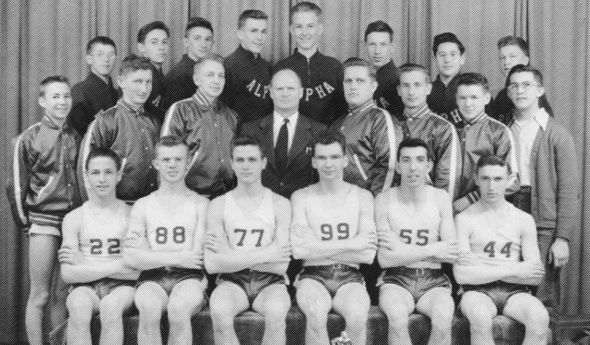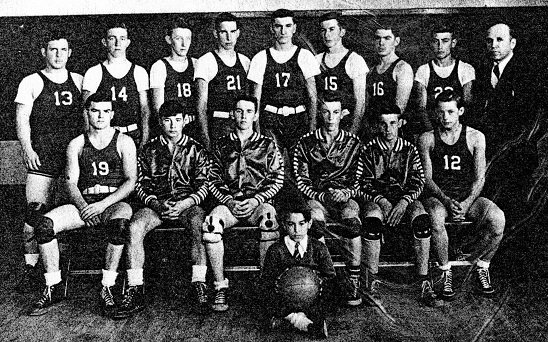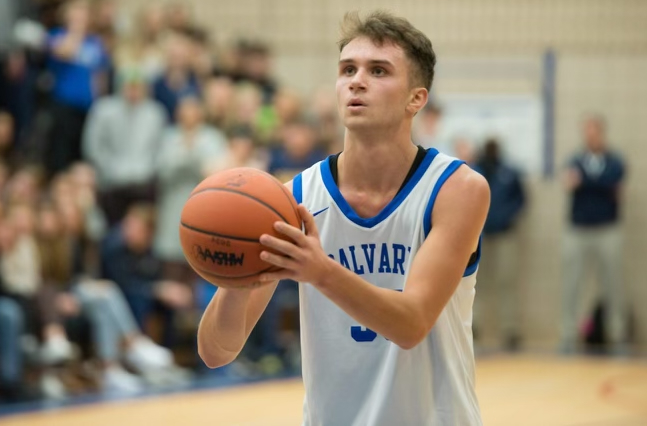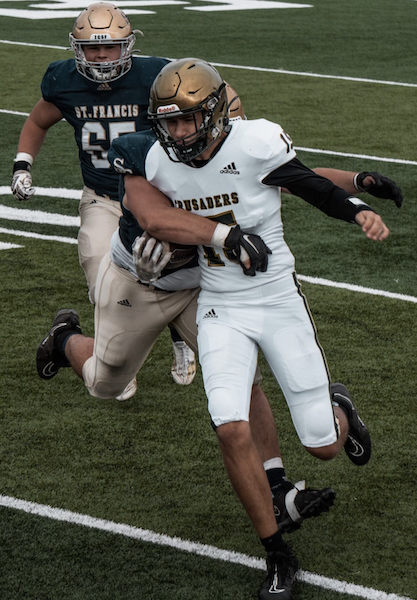
Before the Bridge: Class E & the UP
July 31, 2017
By Ron Pesch
MHSAA historian
This is the final part in a series on MHSAA tournament classification, past and present, that has been published over the last two weeks and originally ran in this spring's edition of MHSAA benchmarks.
The stories are worthy of the silver screen.
Long lost legends of lore, forgotten by most in the Lower Peninsula of the state of Michigan.
Absurd anecdotes of basketball played behind glass, and out-of-bounds lines painted on walls.
Tales of overlooked places like Trenary and Champion and Doelle and Watersmeet.
This is the story of MHSAA Class E basketball.
From 1932 to 1947, Michigan's Upper Peninsula did not compete in the state-sponsored basketball tournament. Instead, the U.P. held a separate basketball tournament, crowning champions in Classes B, C and D. In 1941, the state added a fifth classification – Class E, comprised of schools with a student body numbering 75 or fewer. A fourth bracket was added to the U.P. tourney.
Following the 1948 season, the Upper Peninsula returned to the state tournament. Winners of the traditional U.P. tourney were pronounced regional champions, and advanced to the state quarterfinals in Classes B, C and D. However, since there were no Class E schools with basketball teams in the Lower Peninsula, the winner of the U.P. tournament crown was proclaimed Class E state champion. This arrangement continued through the spring of the 1960 season.
Since they were the state's smallest high schools, the gymnasiums came in all shapes and sizes. Some sported a center circle that intersected with the top of the key. Basketball courts that doubled as a stage required netting to keep the kids and the ball on the court and away from the audience seated below.
Fred Boddy, a former coach at Champion, recalled his first visit to Doelle. Located in copper country near Houghton, the hosts were the proud owners of “the smallest” gym in U.P.
“I couldn't believe my eyes. ... Here on the second floor were windows and bleachers all around filled with fans. The gym, of course, was located on the first floor, but to get into the gym one had to go around to the back of the school to enter through the boiler room to the locker rooms, which opened onto the gym floor much like a dugout on a baseball field. The players sat on a bench under the wall and could look out and see the game in this manner. The free throw lines intersected and there were no out of bounds lines... the wall itself was ‘out of bounds.’ On the floor during the game were 10 players and two referees. There were no sounds as all the fans were up on the second floor, glassed in.
The cheerleaders tried valiantly to fire up the fans up on the second floor, but the teams couldn't hear in the quiet below. The score clock and statistician personnel were placed in a corner box high over the floor in one corner of the gym. They attained this lofty perch by a ladder that was removed from the trap door after all three were in position and the game could thus commence. The timer then tied a rope around his ankle. To send a sub into the game the coach would send the player along the wall heading for this rope. He would pull the rope causing the timer to look down through the trap door and at next opportunity would ring the buzzer and admit this substitute”
Regardless of the challenges presented by these cracker-box gyms, the fans loved their basketball. “The enthusiasm was just the same, if not bigger, than schools twice and 10 times their size,” noted longtime U.P. historian, Jay Soderberg.
Coach Joseph Miheve's 1941 Palmer squad captured the state's first Class E title with a 39-28 win over Hulbert at Ironwood. A graduate of Wakefield High School, Miheve had never played high school basketball, serving as the team's manager.
The 1942 tournament, scheduled for March 19-21, was postponed one week because the city of Marquette was more or less taken over “by nearly 1,000 selective service registrants from every county in the Upper Peninsula” who had another and more serious battle in mind – World War II.
Palmer, this time coached by Elvin Niemi, repeated in Class E with a 37-31 victory over Bergland. It was Palmer's 32nd consecutive victory.
No tournament was held in 1943 due to the involvement of the United States in the war. In the 1944 championship game, Cedarville jumped out to a 19-14 first quarter lead but was held to 24 points in the remaining periods and fell to Amasa, 51-43 at Ishpeming.
Trenary made its lone Class E finals appearance in 1945, losing to Bergland 49-39 at Ishpeming, while the Alpha Mastodons won their first U.P. title since 1934 with a 48-28 win over Champion in 1946. It was the second of five Class E titles for Alpha coach Gerhardt “Gary” Gollakner, one of the finest coaches to come out of the U.P. Gollakner had coached at Amasa two years earlier, and his Mastodons would earn three additional titles during the 19-year run of the Class E championships.
Bergland became the tourney's second two-time winner in 1947, with a 40-37 win over the Perkins Yellowjackets. Perkins made four trips to the Class E finals over the years, including an appearance in the final year of the tournament, but came away empty-handed each time.
The Nahma Arrows made their first appearance in the championship in 1951, losing to Michigamme. Led by coach Harold “Babe” Anderson, a cage star at Northern Michigan College during the early 1940s, the Arrows returned to the finals in 1952. Nahma finished the year with a 21-0 mark and a 64-44 win over Marenisco for the crown.
 The two teams met again in a finals rematch the following year. The scored was tied six times, while the lead changed hands seven times in this barnburner. With 15 seconds to play, Nahma led 64-60. Marenisco's Robert Prosser hit a jump shot, then teammate Bill Blodgett stole a pass and scored to knot the game at 64. With two seconds remaining, Nahma's Bernard Newhouse was fouled. Newhouse hit the first free throw, but missed on the second. Teammate Wendell Roddy tipped in the rebound, and the Arrows had their second title.
The two teams met again in a finals rematch the following year. The scored was tied six times, while the lead changed hands seven times in this barnburner. With 15 seconds to play, Nahma led 64-60. Marenisco's Robert Prosser hit a jump shot, then teammate Bill Blodgett stole a pass and scored to knot the game at 64. With two seconds remaining, Nahma's Bernard Newhouse was fouled. Newhouse hit the first free throw, but missed on the second. Teammate Wendell Roddy tipped in the rebound, and the Arrows had their second title.
Alpha returned to the championship circle in 1954 with a 52-48 win over Perkins.
The 1955 title game matched a pair of the finest teams in Class E history. Trout Creek, making its first championship appearance, downed Alpha 84-83 in another Class E thriller. Don Mackey led the winners with 39 points. Tony Hoholek paced Alpha with 31, while junior John Kocinski added 21-points for the Mastodons.
Kocinski, a four-year starter at Alpha, scored 1,782 points during his career, then an all-time U.P. record. He once scored 51 points against Amasa, and could have scored more according to teammate Walter “Slip” Ball. “He refused to shoot in the fourth quarter, and passed up one shot after another,” Ball said.
Without question, Trout Creek was one of the powerhouse squads during the final years of the tourney. The Anglers, coached by Bruce “Pinky” Warren, a former captain of Purdue's football team, made four trips to the finals during the last six years of the Class E tourney. The defending champions downed Alpha in the semifinals of the 1956 tournament, then knocked off Hermansville 86-68 in the finals to repeat. It was a year of celebration for fans of U.P. basketball, as four of the state's five champions – Stephenson (B), Crystal Falls (C), Chassell (D) and Trout Creek (E) – came from Michigan's northern peninsula.
Hermansville returned to the finals in the spring of 1957 and earned its second Class E title with a 77-51 win over Michigamme at Escanaba. Trout Creek downed Perkins 61-41 for their third crown in 1958.
The 1959 championship, hosted at Northern Michigan College's fieldhouse, was a showdown of the U.P.’s only undefeated squads, Trout Creek and Nahma. Trout Creek was riding a 24-game winning streak that dated back to the 1958 season. A scoring machine, Warren's Anglers averaged 81.7 points per contest. Nahma, 19-0 on the season, boasted the U.P.'s strongest defense. Still coached by “Babe” Anderson, the Arrows had allowed an average of 38.2 points per game. Led by senior Warren Groleau, Nahma had been last defeated by Trout Creek in the semifinals of the 1958 tourney.
Leading 25-15 at the intermission, Nahma matched Trout Creek point for point in the second half for a 55-45 victory.
Hermansville, behind Richard Polazzo's 29 points and Irwin Scholtz's 27, downed surprise finalist Perkins 72-50 in the 1960 finale, to end this chapter in MHSAA history.
Today, most of the former Class E high schools are long gone. Many have closed their doors and consolidated with other area schools. Amasa and Alpha merged with Crystal Falls to form Forest Park. Palmer is now part of the Negaunee school system. Bergland and Trout Creek joined forces with Class D Ewen to form Ewen-Trout Creek. Hermansville combined with Powers to form North Central, to name but a few. A few remain: Dollar Bay, Marenisco (now Wakefield-Marenisco) and Watersmeet, and their enrollments are much the same as in the glory days of the state's fifth classification.
Author’s note: Special thanks to Jay Soderberg and Roger Finlan, who assisted in gathering statistics and quotes used in this article. Thanks also to Dick Kishpaugh, Bob Whitens, Walter “Slip” Ball, Dennis Grall, Fred Boddy, Bruce Warren, Gene Maki, Harold “Babe” Anderson and the various personnel at U.P. high schools for their contributions to this story.
PHOTOS: (Top) The Alpha boys basketball team won the 1950 Class E title by nearly doubling up Michigamme, 52-28. (Middle) Hermansville claimed the 1948 title with a 58-38 win over Rockland.

Not Even Sky Seems Limit as Richards Keeps Calvary Sports Soaring
By
Tom Kendra
Special for MHSAA.com
January 4, 2024
Bradley Richards believes that life is all about trying new things, setting bigger goals and pushing yourself to new heights – in his case, literally.
 Richards, now a 6-foot-5, 190-pound junior basketball standout at tiny Fruitport Calvary Christian, played on the school’s fifth-grade team when he was in second grade.
Richards, now a 6-foot-5, 190-pound junior basketball standout at tiny Fruitport Calvary Christian, played on the school’s fifth-grade team when he was in second grade.
He remembers staring longingly at the rim in those days and dreaming about dunking, before making that dream a reality by throwing one down in February of his seventh-grade year.
While his three older sisters - Taylor, Allyson and Kelsey - were leading the Calvary girls basketball program to new heights, he vowed he would do the same with the boys program someday.
Bradley and his teammates accomplished that goal last spring, winning the school’s first boys District basketball title despite a roster with no seniors.
This season, Calvary came flying out of the gate with a 5-0 start and is now 5-2 heading into Friday’s home game against Saugatuck.
“It’s been a lot of fun,” said Bradley, who averages 29 points and 14 rebounds per game. “Our school is so small that we’re more like a family. It’s not about me. I’m just so happy for our school and all of the guys on the team.”
The next goal is to repeat as District champions and try to win a Regional title, before setting his sights at clearing 7 feet in the high jump this spring.
“I’m going to try to get past that this year,” said Bradley in his typical humble, matter-of-fact fashion.
One thing his father and fourth-year Fruitport Calvary Christian boys basketball coach Brad Richards has learned is to not put anything past his only son, the youngest of his four children.
Bradley displayed an interest in music as a young boy and now sings in the school’s worship group and plays the saxophone, piano and guitar. Last fall, he played high school football for the first time as part of a cooperative agreement with Muskegon Catholic Central and wound up starting at wide receiver and defensive back for the state powerhouse program.
“He’s blessed and he’s gifted – yes,” said his father, who also coached all three of his girls during their Calvary Christian basketball careers. “But he works so hard.
“Bradley sets goals and works toward them. He’s always looking for the next thing to do.”
True to his school
One thing he doesn’t like to do is media interviews. Specifically, he doesn’t like calling attention to himself.
“He is pretty quiet and would rather have his teammates get the attention,” said his mother, Joy.
Fruitport Calvary Christian is one of the smallest schools on the entire Lakeshore with 51 students in grades 9-12, and just 17 boys in the high school.
 The Eagles take great pride in their ability to compete against much larger schools. They made a huge statement during the first full week of December with three convincing victories over bigger schools.
The Eagles take great pride in their ability to compete against much larger schools. They made a huge statement during the first full week of December with three convincing victories over bigger schools.
That week started on Tuesday, Dec. 5, with Calvary’s first-ever boys basketball win over neighbor Fruitport, a Division 2 school that competes in the Ottawa-Kent Conference Blue. Bradley scored 35 points with 14 rebounds in that game, with clutch free throws by role player Eric Dubois Quayle sealing the win.
Two days later, Richards scored 36 points with 17 rebounds in a win over Grand Rapids Sacred Heart.
Calvary then capped the 3-0 week Friday with a victory over Kent City, another Division 2 school, as Bradley scored 36 points with 18 rebounds.
Calvary is led by the “big three” of juniors Richards and Quinn Swanson and senior Sam Zelenka. Swanson, the team’s second-leading scorer with 17 points plus six rebounds and three assists per game, injured his knee last week against Schoolcraft and his health will have a huge bearing on the team’s success going forward. Zelenka is the top defender and averages 11 points, eight assists and seven rebounds.
The other starters are junior workhorse Zach McFarren, who owns the school’s shot put and discus records and has played all but six minutes over the team’s seven games, and senior Nolan Ghezzi.
Richards, already a two-time Associated Press all-state selection who even made the Basketball Coaches Association of Michigan all-state team as an eighth grader, has seen every gimmick defense to try and shut him down, including box-and-twos and triple teams. He credits his experience in football and track with helping him deal with it.
“There is usually a quick guy in front of me and a big guy behind me,” said Bradley, who scored a career-high 47 points in a game last season. “Football has really helped me, because I’m not as scared of the contact. The high jumping has helped me to elevate and get my shot off.”
Great heights
Jim McHugh is a high jump legend from Pentwater who went on to become a two-time national champion in the event at Hillsdale College, and he now coaches West Michigan athletes in the event.
The first time he worked with Bradley Richards, in April of last year, he knew he had something special on his hands.
“Bradley went up and literally hurdled the bar at 5-11,” said McHugh. “I was in shock. I said to myself: ‘This is gonna be a heck of a ride.’ The kid is a generational talent.”
The coaching of McHugh paid immediate dividends, as Bradley improved from a top jump of 6-1½ as a freshman to 6-6½ in last year’s Regional meet. Then came the Division 4 Finals at Hudsonville a few weeks later.
Bradley won the first track Finals championship for Fruitport Calvary with a leap of 6-10 – which was 3 inches higher than anyone else in any of the four Lower Peninsula divisions and entire Upper Peninsula that day – and caught the attention of college scouts from across the country.
 The following week, he competed at the New Balance Outdoor Nationals in Philadelphia and placed second with a jump of 6-8.24.
The following week, he competed at the New Balance Outdoor Nationals in Philadelphia and placed second with a jump of 6-8.24.
McHugh shudders to think of how high his prodigy can soar. He has his sights set on the Division 4 Finals record of 6-10½ (Kurt Schneider, Auburn Hills Oakland Christian, 2009), the Muskegon-area record of 7-0 (Steve Paulsen, Fremont, 1998) and the all-division/class Finals record of 7-1 (John Payment, Brimley, 1989).
“God has given him incredible talent, but he also has the desire it takes,” said McHugh, who is also working with another Division I college high jump prospect in Hart junior Addison Hovey. “I gave him a workout plan, and he has done every bit of it. He has cleaned up his diet, done the cold showers and the cold bathtubs, everything. I’m excited to see the results.”
Richards, whose first love was basketball, admits he is smitten with the high jump and seeing how high he can soar.
Now, when asked about his favorite athletes, he still mentions Michael Jordan and Kevin Durant, but he also includes Olympic gold medalist high jumper Mutaz Barshim of Qatar – who made news by not taking additional jumps at the 2020 Olympics in Japan, thereby sharing the gold medal with Gianmarco Tamberi of Italy.
“I just respect that so much, sharing the gold medal,” Bradley said.
Decision time
Now the Bradley Richards recruiting saga has begun and, for him, it’s not just about choosing what school – it’s also about choosing what sport.
“I would like to do both, play basketball and high jump in college, if possible,” Bradley said.
That would certainly be a possibility if Bradley follows in his family’s footsteps at Cornerstone University. His father was a basketball standout at Cornerstone, which is where he met Joy, and all three of his sisters played for the Golden Eagles. (Kelsey is currently a student assistant for this year’s team.)
Playing both may not be possible if he pursues high jump at the Division I level, where Michigan and Illinois are among schools actively recruiting him.
“I know at some point I’m going to have to make a decision, but I don’t have to right now,” said the 17-year-old Bradley. “So it doesn’t do me any good to sit and stress about it all the time.”
Instead, he is focused on more immediate goals.
The first is figuring out a way for his basketball team to snap a two-game losing skid and get positioned for another postseason run.
Then it will be trying to clear the magical high jump number of 7-0, and beyond. And don’t forget football, where he would love to start off his senior year by helping Muskegon Catholic improve on its 6-5 record from a year ago and make a run at the school’s 13th state football championship.
Only after all of that will it be college decision time.
“It’s not an easy choice, and it will take a lot of prayer and discernment,” admitted Richards, who will look for help from his immediate family and his school family in making his choice. “I’ll figure it out. I usually do.”
 Tom Kendra worked 23 years at The Muskegon Chronicle, including five as assistant sports editor and the final six as sports editor through 2011. E-mail him at [email protected] with story ideas for Muskegon, Oceana, Mason, Lake, Oceola, Mecosta and Newaygo counties.
Tom Kendra worked 23 years at The Muskegon Chronicle, including five as assistant sports editor and the final six as sports editor through 2011. E-mail him at [email protected] with story ideas for Muskegon, Oceana, Mason, Lake, Oceola, Mecosta and Newaygo counties.
PHOTOS (Top) Fruitport Calvary Christian’s Bradley Richards stands atop the podium after winning the high jump last spring at the Lower Peninsula Division 4 Finals. (Middle) Richards lines up to shoot a free throw. (Below) Playing as part of a cooperative with Muskegon Catholic Central, Richards works to get away from a Traverse City St. Francis tackler. (Track photo courtesy of Joy Richards; basketball and football photos courtesy of Local Sports Journal.)

